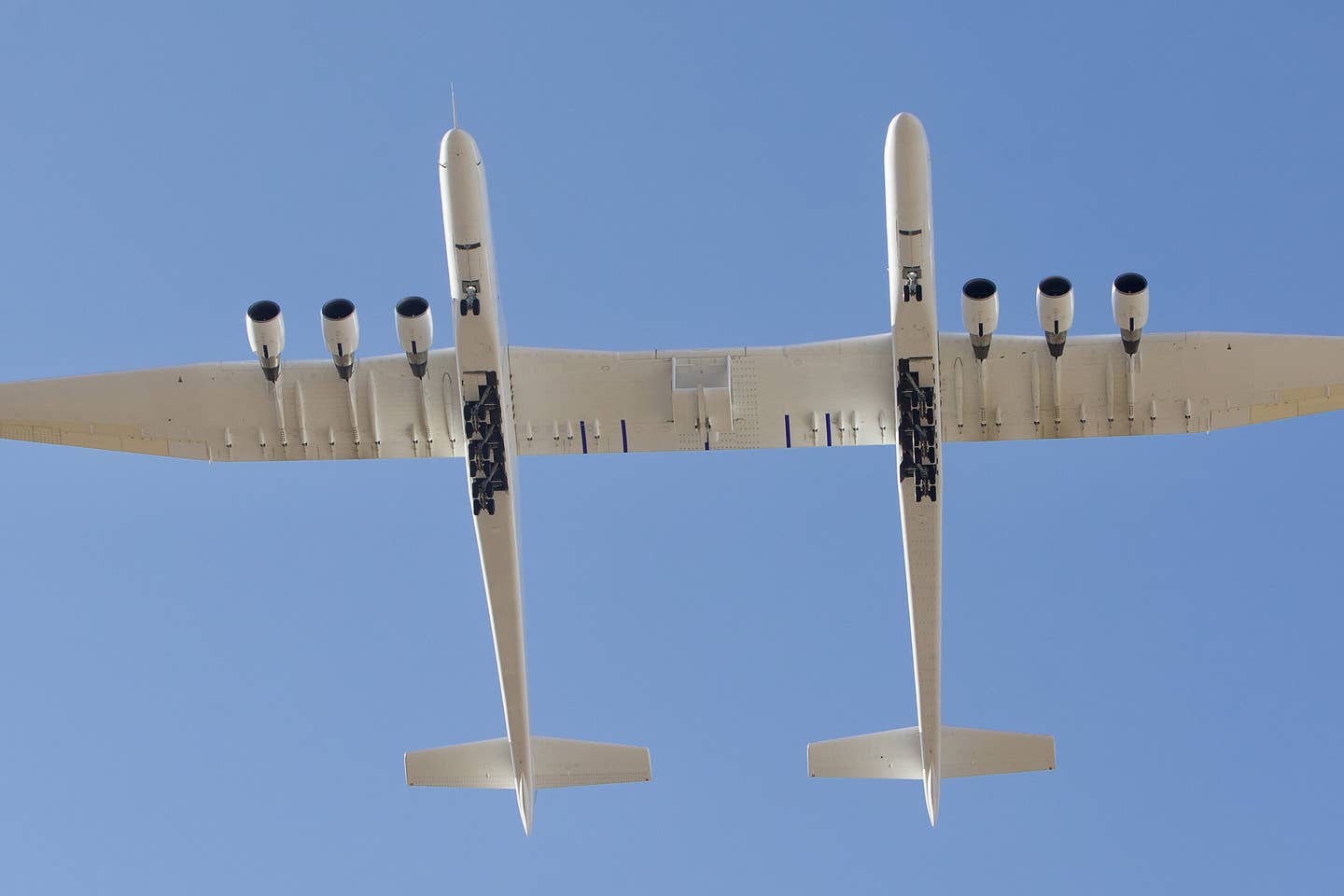Sensor Malfunction Shortens Stratolaunch’s Sixth Mission
Test flight crews for Stratolaunch’s Roc shortened their mission Thursday after a malfunctioning sensor near the airplane’s left elevator on the left fuselage.

During Thursday’s mission, Roc was expected to gather flight data on its new carrier pylon and to expand its flight-test envelope. [File Photo Courtesy: Stratolaunch/Domenic Moen]
The sixth test flight for Stratolaunch’s Roc was abruptly shortened Thursday over California’s Mojave Air and Space Port (KMHV) after a sensor malfunctioned near the airplane’s left elevator on the left fuselage.
During a mission that Stratolaunch expected would last 3.5 hours, the flight crew chose to land the aircraft safely after an hour and 26 minutes.
“We opted to just land, fix the sensor, and we’ll try and get airborne again very soon,” chief technology officer Daniel Millman told FLYING. “It was not a big deal at all. We were all disappointed, but without instrumentation, it’s not really a test flight.” Millman said they were able to achieve a limited amount of testing before the flight was shortened. Roc flew to a maximum altitude of 15,000 feet during the mission, Stratolaunch told FLYING.
The next test flight is expected “fairly quickly,” he said, and could be a longer duration to make up for this shortened mission. “We’ll figure out what test cards we can remove from the deck and what other cards we could add. That will be up to flight ops to see what they can do to keep us moving forward. Obviously, we’ve got a schedule we’re trying to stick to.”
Immediately after Roc landed, Stratolaunch announced it had “encountered a test result that made it clear we would not achieve all objectives for this flight. We made the decision to land, review the data, and prepare for our next flight.”
The world’s largest airplane by wingspan went wheels up from Runway 30 around 8:15 a.m. PT, on an intended mission to expand Roc’s flight test envelope.
Albeit shorter than originally expected, this flight took place during a critical time in Roc’s development, as pilots, engineers, and technicians work to complete a complex flight test campaign aimed at making the airplane fully operational by next year.
Remember, this is an airplane with a very particular set of attributes, including:
- a 384-foot wingspan, longer than an NFL football field
- six Pratt & Whitney model PW4056 engines, acquired from Boeing 747-400s
- a 50-foot height, from the deck to its vertical stabilizers
- eight landing gear, acquired from Boeing 747-400s
- a 1.3-million-pound maximum takeoff weight (MTOW)
New Data Test Boom
Roc was flying with a data boom attached to its 15-foot-by-15-foot, 8,000 pound pylon hanging from the jet’s center wing, where a Talon-A hypersonic testbed vehicle will eventually be mounted.
“The pylon air data boom will measure the aero environment near Talon-A to ensure we meet our release criteria for future Talon-A launches,” Brandon Wood, senior director of programs at Stratolaunch told FLYING Wednesday. “While Roc also has air data instrumentation on the right cabin, the size of the aircraft warrants a dedicated boom close to Talon-A.”
The mission took place just five weeks after Roc’s previous flight, demonstrating a quickening flight operations tempo toward achieving operational status next year. The previous gap between flights was twice as long. The flight was intended to help engineers perfect the pylon for eventual use as a flying launching pad for hypersonic test vehicles.
The pylon is the linchpin of Stratolaunch’s business model. The company has already lined up military and commercial contracts to launch small, autonomous, rocket-powered, hypersonic testbeds from altitudes around 35,000 feet. Without a pylon—the critical point where a testbed attaches to the airplane—Roc’s business model falls apart.
Although the airplane was created to serve as a universal air-launch carrier for multiple payloads up to 550,000 pounds, the current pylon is not designed to lift that much weight. But future iterations could be.
Before flight, the hypersonic test vehicle mates with Roc via a winch that’s built into the pylon. Stratolaunch demonstrated that process in a video shared on Twitter.
Aside from gathering inflight data on the pylon, the test flight team for the sixth mission expected to continue expanding Roc’s flight test envelope, exploring higher altitude levels and increased air speeds.
In the coming months, crews will conduct functional and integration testing on the testbed vehicles to ensure the jet successfully completes its first captive carry flight and a safe separation test. Roc isn’t expected to be fully tested and operational until mid to late 2023.
Why It Matters
As the federal budget reflects intensifying efforts to develop hypersonic weapons, Stratolaunch has already committed Roc to air-launch vehicles for “threat replication” in hypersonic research by the Missile Defense Agency.
Developing hypersonic weapons systems is a “national security imperative,” Stratolaunch CEO Zachary Krevor said last month during a news conference in Washington, D.C.
The U.S. has been actively pursuing the development of hypersonic arms—weapons that can fly at speeds greater than Mach 5—since the early 2000s. Interest by the Pentagon has increased in response to advances by Russia and China.
Defending against hypersonic weapons presents a more difficult set of challenges than traditional intercontinental ballistic missiles (ICBM). This is because ICBMs are launched into a highly predictable and more easily trackable parabolic trajectory, while hypersonic missiles can fly thousands of miles at much lower altitudes, performing extensive maneuvers to evade ground-based radar systems.
For this reason, officials have said tracking hypersonic weapons has become a key part of U.S. defense strategy. Developing these kinds of tracking systems will require “threat hypersonic missile surrogates” that can help scientists evaluate their effectiveness, according to a Department of Defense report. Theoretically, testbed vehicles launched from Roc could serve in these kinds of surrogate roles.

Sign-up for newsletters & special offers!
Get the latest FLYING stories & special offers delivered directly to your inbox






